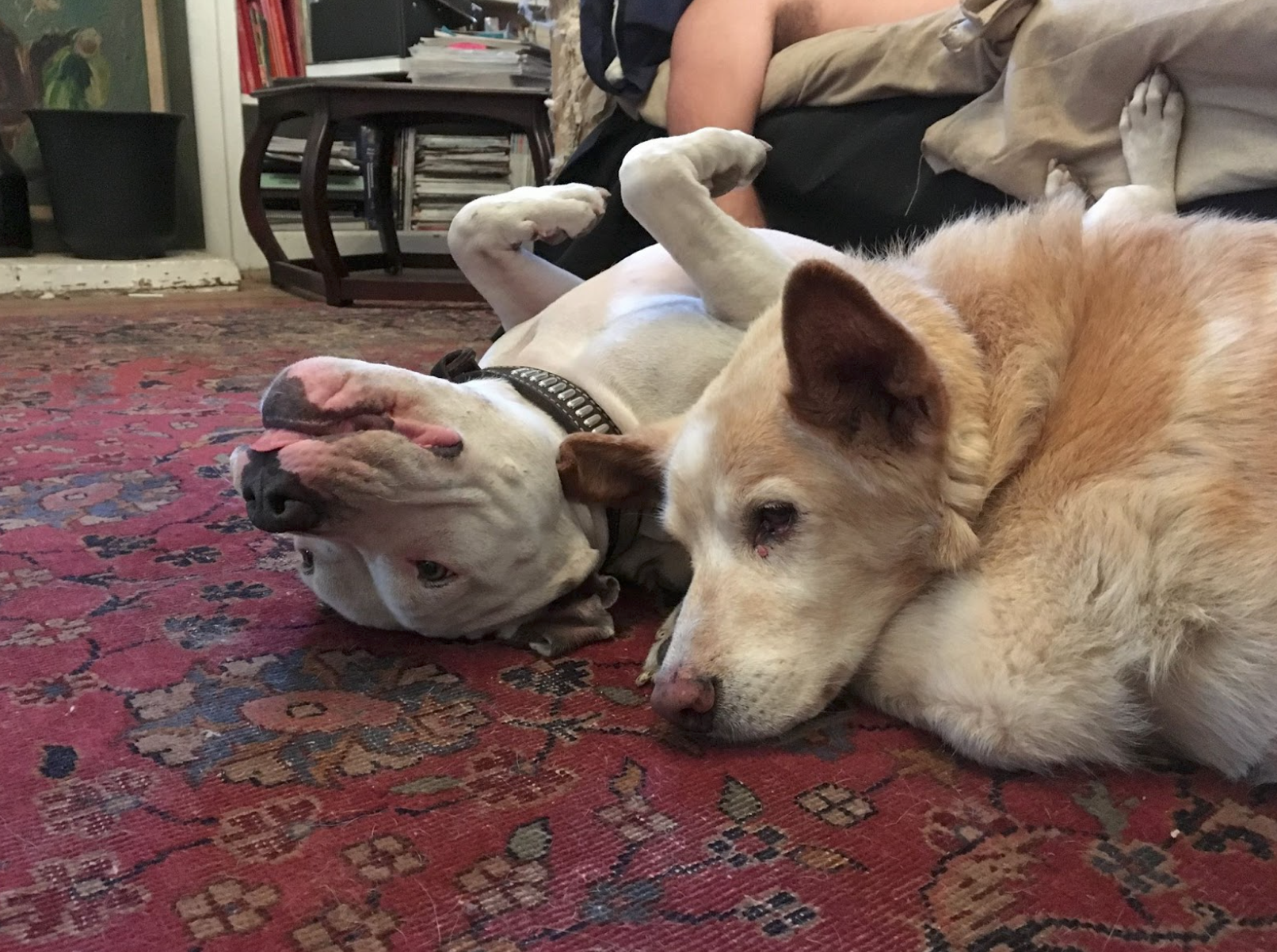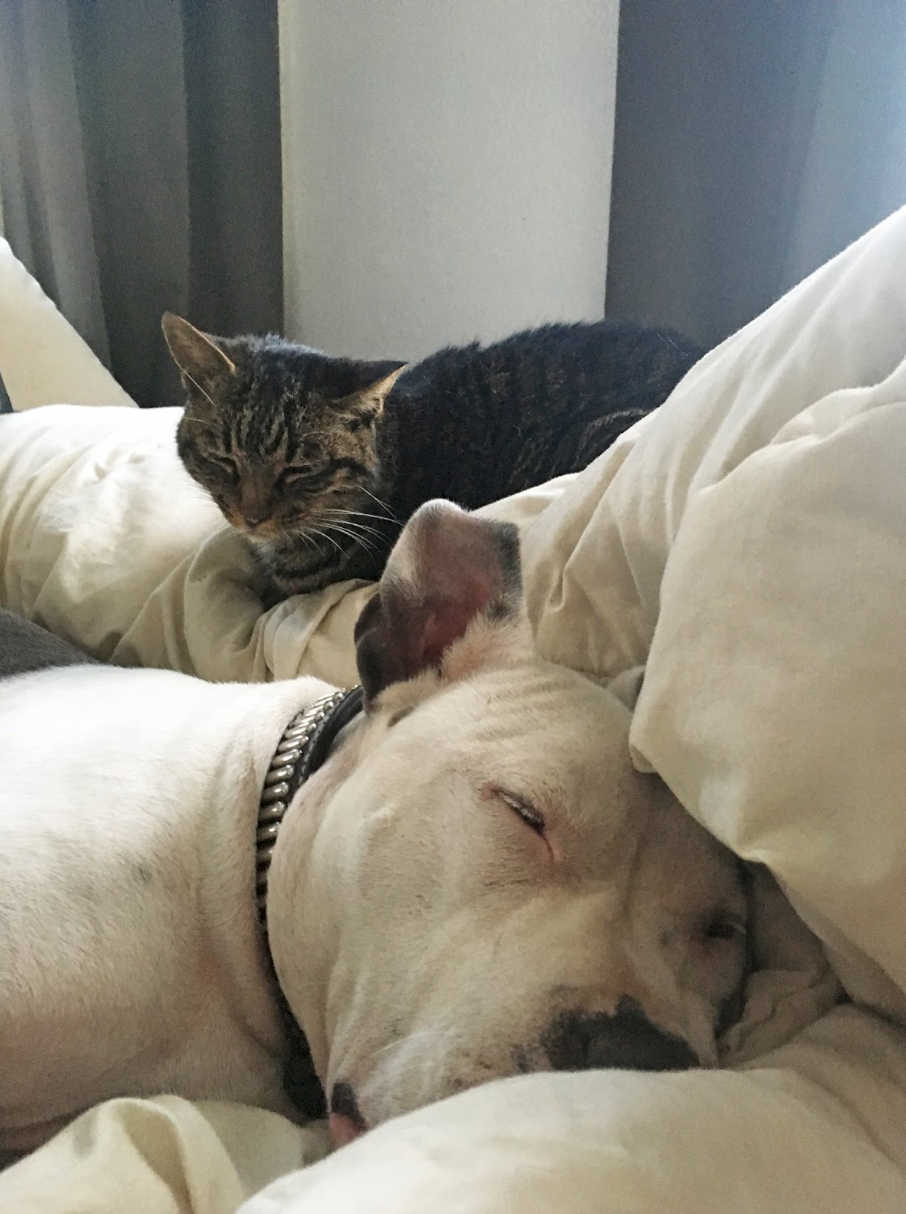Foster homes are the most important role in rescue. We rescue dogs from local animal shelters. Sometimes the dog(s) we rescue have obviously been someone's pet, like 2018 alumnus Hagrid (who already knows his basic obedience) and sometimes you can tell the dog(s) have never felt affection or played with toys, let alone be house broken or crate trained. So our foster parents have to be prepared for everything.
This list of foster resources will help you get started off on the right paw!
Fostering, First the Basics
One of the most important ingredients to a successful foster experience is your partnership with the group that you work with. These are the people who will - ideally - support you during the weeks and months that you have your dog. You should never feel alone with this big project, so make sure the group you hope to help has a good track record with solid adoptions and that they take matching foster dogs to foster homes as seriously as they take creating those final adoptions. Using drama and desperation to find homes shows up in some rescue circles, but it's not a sustainable way to do business. Avoid drama junkies.
It's a good idea to look over a group's foster home contract in advance to make sure you like what you see. Will they help you with obedience training? Vet care? Your family vacations? How will they problem solve and promote?
In return for being a good support system for you, your group will want to know that you're willing to follow their guidelines and instructions and that you'll be good about communicating questions and concerns that will undoubtedly come up along the way. No question is stupid - really. Ask, ask, ask.
An experienced group will want to get to know you, your lifestyle and your skill level before giving you a dog to foster. They'll want to see if your personal dog has good manners and if he's comfortable with sharing his home. (Your dog doesn't have to be friends with your foster dog - but he should tolerate its presence. More on that later.) They'll also want to make sure that everyone in your household is okay with the project and willing to participate in some way, especially, with double-checking those doors and gates, and reinforcing the new house manners you'll be teaching the dog.
These are some beginning need-to-knows offered to us by BR trainer Linda Chwistek. Linda is usually repping 1-3 dogs for BR. That means she's over-seeing the details of 'her' dogs' progress and making herself available to the foster homes as questions come up. Anyone who fosters with Linda learns a ton about dog training - lucky them.
The dogs coming from shelters often smell bad and have fleas. You aren't getting a shiny coated, well mannered, clean house pet. You will be proud when you make him one.
Fostering can be long term so be ready to make a commitment. It's fun, it’s rewarding, but it can take time to find the right match for your foster.
Know you own pets and their needs. If your personal dog is 15 and wobbly, let us know so we can match up a dog that will be suited to yours.
Just because your dog doesn't chase cats doesn't mean a foster won't initially think that’s a fun game. Let us know if you have a cat, make sure your foster has been cat tested, and follow introduction instructions (We'll get back to those -- promise)
The dogs coming from shelters often have kennel cough. And sometimes they get sicker before they get better. It'll go away, but come up with a plan to keep the KC germs away from your personal dogs until your foster is well.
Fosters might develop a behavior you find odd or interesting. You may find tail chasing cute, but it can be an obsessive behavior that has to be handled. Always bring up any new or odd behaviors. They could signal health issues or a behavior that needs to be addressed with training.
Let you neighbors know you have a foster and if possible, have them see/meet him. If he inadvertently gets out, they may recognize him.
Above: Christine Allen and her son Sam. This family fostered Vick dog 'Teddles' until he found his home. Photos: Carol Guzy, Washington Post.
Content Source: BADRAP
Time to Transition
Being excited to bring home a new foster or any dog, for that matter, is a natural feeling. Of course we want you to enjoy all the love that your new dog has to offer, but it's important to remember that even though you are offering them a better life, they are still going through a major transition period. Your new dog will need time to decompress before they are ready to integrate into your home. Offer them a safe quiet place to relax and decompress. Below is an article from the Huffington Post, it provides detailed step by step instructions and explanations for what your new dog is feeling during this time. Though it may feel like a lot of extra steps to us, it's much better to break that transition down into smaller steps to set your new foster dog up for success from the beginning than have to troubleshoot potential issues later.
Go Slow!
The old adage, you never get a second chance to make a first impression is true for dogs too. You are better off taking dog introductions slow and AVOID a potential fight. Here's a great video about managing a multi-dog household.
The Golden Rules of Multi-Dog Management:
Select your pets with care. Some dog pairs have great chemistry while others are Jerry Springer material - Nothing but conflict and strife. Set boundaries so the dogs know and respect the house rules. Especially while dogs are getting to know each other, separate before you leave the house. Know the most common fight triggers and work to prevent them. Involve everyone in the household in multi-dog management. Understand that dog dynamics can and do shift along with life changes. Give your dogs individual attention to strengthen bonds.
Managing Problem Behaviors
The majority of problem behaviors which we identify in shelter dogs are normal canine behaviors - behaviors that are not any different than those we see in owned dogs. The difference with shelter dogs is that in many cases no one has shown them alternative, more acceptable behavior.
Our friends at the Center for Shelter Dogs has created these resources to help manage problem behaviors:
Food Aggression
The first thing we would like to state about food aggression is that we agree with this piece from the NY Times that the food bowl assessment test is not an accurate predictor of behavior. However, oftentimes we are pulling an unknown dog and placing it within an environment with other animals. Therefore, we still preform a food bowl assessment knowing that sometimes the dog may not guard food at all when it leaves the shelter and/or a dog with no food bowl possessiveness in the shelter may exhibit it out.
Food Aggression Management Tool
Dogs with food aggression may stiffen their body, show teeth, growl, snap or bit when they are approached by a person or another animal when they are in possession of or near a food-related item such as a rawhide chew, bone, pig's ear, food bowl, sandwich wrapper, or food that was dropped on the floor. Dogs with food aggression are likely to behave aggressively around items that they consider delicious. For example, most dogs are more likely to behave aggressively over a bowl of canned food or pig's ear than over a bowl of dry food.
These videos illustrate the different levels of food aggression.
1. Mild Food Aggression: Dog shows teeth and/or growls when approached or touched by a person or fake hand when in possession or near food or a food-related item.
2. Moderate Food Aggression: Dog snaps and/or lunges when approached or touched by a person or fake hand when in possession of or near food or a food-related item.
3. Severe Food Aggression tendencies: Dog bites when approached or touched by a person or fake hand when in possession or near food or a food-related item.
Mild Aggression
Moderate Aggression
Severe Aggression
Dog Cat Intro’s - Slow and Steady wins the race
When Amy and James asked BADRAP to adopt Matzo Ball, they told us they had two cats at home, in addition to their two dogs. Would it work?
The dog part would likely go smoothly but the cats were a concern. We were very honest: “He can be an excitable guy and he’s shown some prey drive towards squirrels and birds. We believe he could injure your cat if intros go too fast. BUT, if you take intros nice and slow – and in, weeks-slow rather than hours-slow, and if you stage your intros and monitor every step, we think he could eventually learn to live nicely with everybody.”
The cats’ personalities factored in to the equation as much as Matzo’s. Amy and James told us that one of their cats was fearless and would likely rush Matzo, while the other cat would probably be nonplussed. Knowing that a rushed intro would be more than Matzo could handle, they set up a plan to create the best success. During this intro period, Matzo was with them under a foster/adopt contract and he was marked as having a ‘pending’ adoption. We agreed to hold off on going full adoption until the household had found a healthy and successful rhythm between all the various creatures.
Long story short, it worked. They did such an impressive job making it work that we asked them to bullet out their step-by-step for future adopters. Here’s how they got success:
Amy and James broke their intros process down into separate phases and waited to see solid success before pressing on. Smart. They said. "Philosophically, we followed similar guidelines to introducing our cats and Matzo Ball as this BR post. We tried to make sure that all interactions, however brief, were positive for both Matzo and the cats. We tried to set things up so that the cats could end the interaction whenever they wanted to, and only moved on to the next phase when Matzo was consistently appropriate at each level of interaction.”
Ingredients for their success:
Doors and a dog crate for safe separating
Leashes and a Tie-down for managed intros
A squirt bottle for corrections
Training lessons for Matzo (distraction work)
Places for the cats to retreat to
A good game plan, good communication between the humans.
Plenty of patience, time and a can-do attitude.
Phase One: ‘I Smell You’
"Matzo had no visual contact with the cats at first -- We wanted him to just get used to their smell. We closed off the room with Matzo’s crate so our cats couldn’t get in and so he couldn’t see the cats. The way our house is laid out allowed us to also vary the amount of space between Matzo and the cats -- we started with three sets of closed doors between everyone, then went to two, and then one (plus a crate). We’d also periodically bring Matzo into the rooms that the cats had been hanging out in so he could investigate their smells, and brought some of the cats' beds to him, too.
Our biggest challenge during this phase was actually our brave cat, who wanted to see Matzo so badly he tried to sneak into the rooms he was in. We didn't want Matzo's first face to face with the cat to be when he was excited, so having a cat run at his crate head-first was not part of the plan."




Phase Two: Closed door ‘Greetings’
"Once Matzo thought smelling cat bedding was boring, we had our cats in adjoining rooms so he could get used to their sounds without actually seeing them. Any extreme excitement -- attempts to paw at the door, whining, or get into the room with the cats, for example -- were discouraged immediately with a sharp NO and, if he persisted, a quick spray bottle squirt.
The challenge with this phase was again our brave cat: when she heard Matzo sniffing the door, she would stick her paws under the door to get at him.
This was the longest, most challenging phase for everyone; the cats didn’t like being cooped up, and it was difficult for Matzo not to get excited when our cat initiated a game of Whack-a-Mole under his nose."
Phase Three: ‘I See You and I’m Trying to Stay Calm!’
"Once Matzo was consistently showing appropriate interest in the cat paws emerging from under the door -- polite sniffing, but no whining, pawing, barking or fixed staring -- we let Matzo see the cats for the first time. We started with him in his crate allowing him to see us holding a cat through a glass door in the next room. If the cat wanted to leave or if he showed any overt excitement -- barking, whining, panting, pawing, fixed staring -- we told him no, removed the cat and redirected his attention."
(Note from BADRAP: Matzo was learning how to stay calm and focused on his handler around exciting distractions during Saturday Pit Ed class exercises. )
"Once he was appropriately calm when he saw a cat through the door, we tried bringing the cats into the same room with him while he was in his kennel. Next, we had our cats in the same room as him while he was on at tie-down. And then finally, Matzo could be on leash with the cats in the same room.
This phase didn’t actually last long. Again, our brave cat was more of a challenge than Matzo. When she saw the dog, she’d try to get away from us and run over to him.
When Matzo was calm on leash around the cats, we allowed him some off leash time in the room. We made sure there were always places for the cats to retreat to if interacting with Matzo was too much, and supervised these interactions extra closely.
We were lucky that our cats were already very calm around dogs -- they don’t run away when they see a dog, which means that there are few opportunities for Matzo (or our other dogs) to chase the cats. Being around our other dogs who knew the rules about cats also helped Matzo learn pretty quickly."
Important Info from Amy & James:
"Our cats are also indoor-only cats. Matzo will still bark at and chase the feral cats in our neighborhood that wail on our fence. He still doesn’t have unsupervised interactions with our cats. When we’re not at home, he stays safe in his crate… although our brave cat’s favorite sleeping spot is on top!"
Three cheers for smart adopters and their agreeable animals.
Follow Matzo's Instagram Updates: BlanketMonsters
SOURCE: BADRAP






